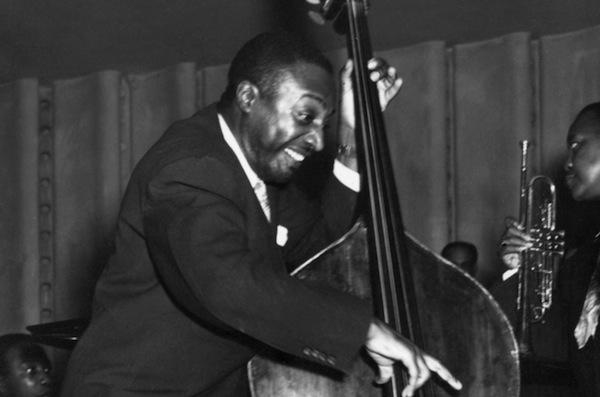Oberlin Honors a Jazz Legend Through Unprecedented Relationship
April 22, 2014
By Erich Burnett

Milt Hinton performs with Cab Calloway’s band in Havana, Cuba, 1951.
Photo credit: The Milton J. Hinton Photographic Collection
Jazz musician Milt Hinton touched the lives of thousands of artists and audiences across a career that spanned more than 70 years. Through it all, “The Dean of Jazz Bassists” chronicled his experiences through countless photographs and other documents, which today serve as a fascinating window into the world of this great artist and the masterful musicians with whom he played.
Thanks to a multifaceted new relationship between Oberlin and the estate of the late bassist, Hinton’s legacy will be felt for generations to come:
• The Oberlin Conservatory has acquired four of Hinton’s basses, including the Italian instrument Hinton bought in the late 1930s and played throughout his career.
• The Hinton estate has donated to Oberlin a voluminous collection of papers amassed by Hinton and his wife Mona—everything from personal journals, to correspondence with music legends, to contracts from memorable shows. The Milton J. and Mona C. Hinton Papers will play an integral role in the curriculum at Oberlin.
• Oberlin’s Allen Memorial Art Museum will feature an exhibition in fall 2014 of 99 photographs taken by Hinton, which will be accompanied by a series of gallery talks, lectures, concerts, and other related events.
At the heart of the relationship is the inaugural Milt Hinton Institute for Studio Bass, an intensive week-long program for college and pre-college bassists that takes place on the Oberlin campus June 8-15. Led by a roster of distinguished bass performers and educators, the institute will include master classes, performances, ensembles, and more, and will encompass the full spectrum of styles, from jazz to classical. The Hinton Institute will be held every other year.
“We are enormously grateful to the Hinton estate and deeply honored to play a lead role in preserving the legacy of Milt Hinton,” says Andrea Kalyn, dean of the Oberlin Conservatory. “This profound collection truly brings to life the formative years of jazz history, and affords unprecedented insight into the people and places behind the music. It will serve as an invaluable resource to current and future generations of students and scholars at Oberlin and throughout the world.”
To help support the institute and qualified students interested in attending, Oberlin has also been gifted the $250,000 Milton J. Hinton Scholarship Fund, which was established in 1980 by friends and family of Hinton on the occasion of his 70th birthday.
“Milt and Mona Hinton were committed to leaving their papers and memorabilia—their gift—to an institution that would not only appreciate and care for it, but would also make everything readily accessible to anyone who was interested,” says David G. Berger, a lifelong friend of the Hintons and co-executor of the Hinton estate. Along with his wife Holly Maxson, Berger has devoted more than 30 years to organizing the Hintons' photographs and artifacts.
To Berger, Oberlin was the “obvious choice.”
“A part of Oberlin’s uniqueness is its tradition of educational excellence in both music and the liberal arts," he says. "We recognized that the Hintons’ gift would appeal to and be useful to a broad range of students and scholars in the music world, but it would be equally attractive to those in the social sciences and humanities."
Oberlin’s partnership with the Hinton estate was facilitated by Oberlin Professor of Jazz Studies and Double Bass Peter Dominguez and Special Collections Librarian Jeremy Smith.
“Milt Hinton's contributions as a musician and humanitarian remain unique and genuine,” says Dominguez, who was a friend of Hinton’s and, as a young performer, won the first-ever Milton J. Hinton Scholarship. “He represents an exceptional example of longevity in an illustrious performing career and a righteous individual who lived his life with honesty and relevance.”
Oberlin’s relationship with the Hinton estate further bolsters its reputation as a world leader in the study of jazz. The institution’s profound commitment is evidenced in its four-year-old Bertram and Judith Kohl Building for jazz studies, which houses the Hinton Collection, the more than 100,000 recordings that make up the Neumann Jazz Collection, and the nearly 200 images that constitute the Frank Kuchirchuk Collection of Jazz Photography.
You may also like…
Josh Nolan Named Vice President, General Counsel, and Secretary at Oberlin
Distinguished attorney brings extensive experience in higher education law.
Learning by Teaching: Oberlin Students Share Global Music with Young Learners
College and Conservatory students in PACE 103 prepare local children for an immersive community concert at Oberlin.
Nuiko Wadden ’02 Joins Oberlin Conservatory Faculty as Assistant Professor of Harp
The versatile musician brings extensive opera, orchestral, and contemporary music experience to her role


